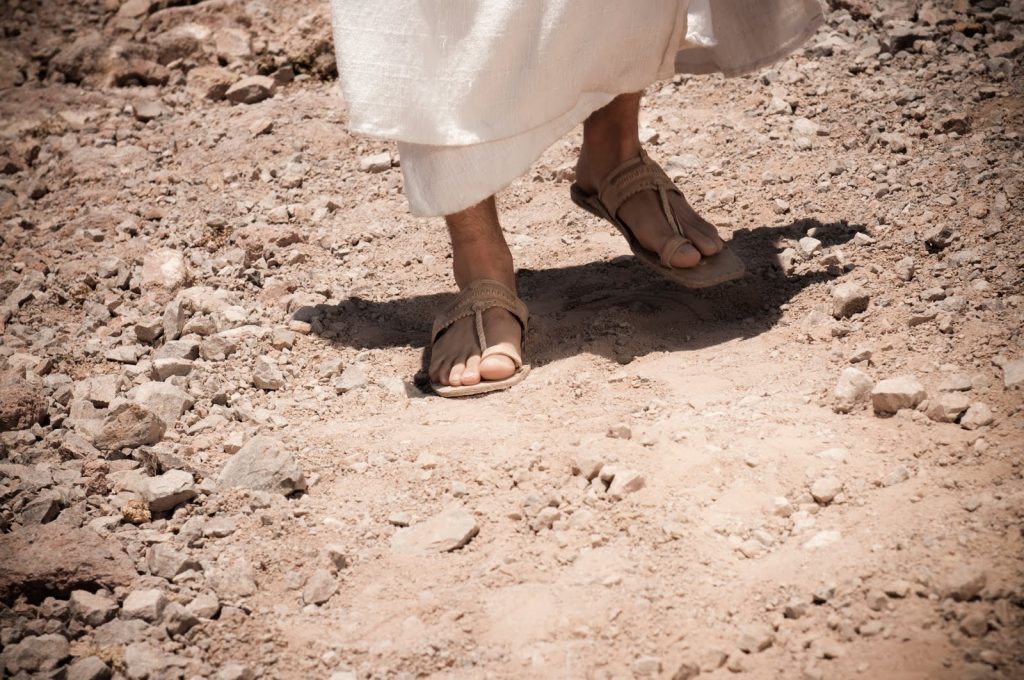Index of Shalom February 2013
3rd Week in Ordinary Time
4th Week in Ordinary Time
5th Week in Ordinary Time
1st Week of Lent
2nd Week of Lent
Feast of Courage, Feast of St. Leo Mangin, SJ

Fr Mangin filled various positions during his years as a missionary. In 1900 he was stationed at Zhujiahe, a small town with 400 inhabitants but whose number soon grew to 3000 by incoming refugees because the Boxers, a secret Chinese society whose members extolled physical prowess and engaged in rigorous gymnastic exercises, were attacking the neighbouring areas. Fr Mangin was aware that the Boxers would one day invade his village wisely fortified it as best as he could including stocking up with a supply of food provisions. As superior of the district he also asked Fr Paul Denn who was then stationed in Gucheng to come to Zhujiahe as his assistant.
Paul Denn was born in Lille, France. He worked as a bank clerk to support his widowed mother before he entered the Society at Amiens on July 6, 1872. He had thought of becoming a foreign missionary but had to shelf his desire because of his family circumstances. He however became an active lay apostle among his fellow workers and a member of the St Vincent de Paul Society. It was only after he was twenty-five that he was able to leave home for the Jesuit novitiate. He was sent to the China mission shorting after and was ordained there on December 19, 1880.
The Boxers first attacked Zhujiahe on July 15, 1900 but they were quickly repulsed by the villagers who were well prepared. They were also able to bravely defend their citadel the following day when the Boxers attacked them again. However on the 17th, when 2000 of the imperial army who were on its way to Peking (now Beijing), joined the Boxers, Fr Mangin saw that his people were badly outnumbered and knew that their defence would not hold for long. Although some people secretly left that evening, the remaining continued to defend themselves as best as they could. Although the priests were encouraged to depart so that they could continue their work elsewhere they chose to remain with their flock.
By the 20th the Boxers managed to construct towers that enabled them to scale the barricade and enter the village. With hope waning, Fr Mangin gathered the women and children into the chapel and there he and Fr Denn sat, facing the congregation, and led them in prayer. As the shouts and the sounds of gunfire grew louder and closer, some of the women began to panic, but Fr Mangin calmed them down saying: “Just a few minutes more and we will all be in heaven.” The few remaining men, unable to withstand the onslaught of the final attack, staggered into the chapel and everyone waited for the end to come.
The Boxers broke down the church doors at around 9.00 am and saw a congregation on its knees in prayers and two bearded Jesuits at the altar. Meeting no resistance the Boxers initially offered to spare all those who would renounce the faith but only a frightened few did. Then the massacre began. With the first round of gunfire, Fr Denn intoned the Confiteor and Fr Mangin pronounced the words of absolution. The two priests were the first to fall to the chapel floor. With the priests dead, some of the brutish Boxers began shooting indiscriminately into the congregation, while others slashed at their victims with swords. They finally set fire to the roof and the chapel was filled with smoke. A few people escaped through the windows, uttering words of apostasy, but the majority of the Zhujiahe Catholics remained at the altar of holocaust.
The bones of the martyrs remained in the place of sacrifice until 190, when they were collected and placed in fifty-seven coffins and were later buried in a new church erected on the same site. The death toll on that July 20, 1900, totaled 1,370 Catholics.
On April 17, 1955, Pope Pius XII beatified Fr Leo Mangin and Fr Paul Denn, together with Fr Modeste Andlauer and Fr Remy Isore another two Jesuits who received their martyrdom on June 19, 1900 at the Weixian mission, and fifty-two Chinese Catholics, chosen from the great number of Boxer martyrs, estimated to be 30,000.
What’s So Funny about Faith?
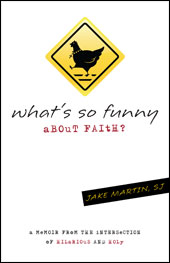
by Jim Manney
In a religious order known for welcoming men with unusual backgrounds, Jake Martin stands out. Before entering the Jesuits, he was a stand-up comedian in Chicago. He still writes and performs; this summer he appeared at the Edinburgh Fringe Festival in Scotland, which calls itself the largest arts festival in the world. Jake tells the story of how a comic joined the Jesuits in his book What’s So Funny about Faith?, just published by Loyola Press. Read an excerpt here.
You can get a taste of Jake’s schtick in this mock commercial for the Jesuits. After the comic bit, he talks about his vocation.
Jake Martin, SJ, is a Jesuit comedian and writer from Chicago. He is a regular contributor to America magazine and Busted Halo and performs stand-up and improvisational comedy in Chicago and New York. Jake currently teaches improvisational comedy and theater at Loyola Academy in Chicago.
Film Reviews : Jack Reacher
by Rev Dr Richard Leonard SJ

JACK REACHER. Starring Tom Cruise, Rosamund Pike and Richard Jenkins. Directed by Christopher McQuarrie. 130 minutes. Rated M (violence and infrequent coarse language).
Many of Lee Child’s readers of the Jack Reacher novels (including this reviewer), know that he is a former military policeman, now a loner, who continually gets caught up in other people’s problems despite himself. He is tough, laconic (though also sardonic), standing at five feet six and weighing 250 pounds or so.
So, who thought of having Tom Cruise (a foot or so shorter and some years older) for the screen version of Jack Reacher?
Despite strong misgivings, I will admit that Tom Cruise is not too bad at all. Lee Child himself remarked that in the books Jack Reacher is like a sledgehammer whereas in the film, he will be more like a scalpel. Maybe. Tom Cruise does get the opportunity to go the sledgehammer route. The main difficulty is not his height but that, despite many Mission Impossible actioners, his face does not look as lived in as Jack Reacher’s should be. Despite the long career, Tom Cruise still has touches of the baby-face.
One other thing for Reacher readers. This film version of One Shot is a pretty good adaptation of the novel. The first ten minutes or so are exact, with a lot of detail, which can reassure hesitant readers. Needless to say, a number of characters are shed, but the core of the novel is faithfully followed for screen action rather than merely being literal.
For those not familiar with the novels and character, Jack Reacher should prove an interesting, even intelligent, mystery action thriller.
A shooter who has shot five victims in the city centre is arrested and asks for Jack Reacher. It is assumed that he is to witness to the character of the shooter. Not at all. The two have a difficult history. This baffles the shooter’s lawyer (Rosamund Pike), the DA (Richard Jenkins) who happens to be the lawyer’s father, and the chief of police (British Shakespearean actor, David Oyelowo).
This is one of those things are not what they seem tales and it is interesting to see where incidents and clues lead us. Some lead to a veteran shooter, played with his pleasing customary bluff by Robert Duvall, and to a mysterious Russian who is played, capitalising on his sinister voice and accent, by celebrated director, Werner Herzog.
While Jack Reacher does have some fights and Cruise makes them credible enough, there is a car chase, probably the visual equivalent of the physicality of fists, kicks and blows.
We probably won’t mind if this is the beginning of a movie franchise – but Mr Cruise is now venturing into his 50s as should be the literary Jack Reacher.
Rev Dr Richard Leonard SJ is the Director of the Australian Catholic Office for Film and Broadcasting (ACOFB).Peter W. Sheehan is associate of the Australian Catholic Office of Film and Broadcasting.
Suffering for Christ
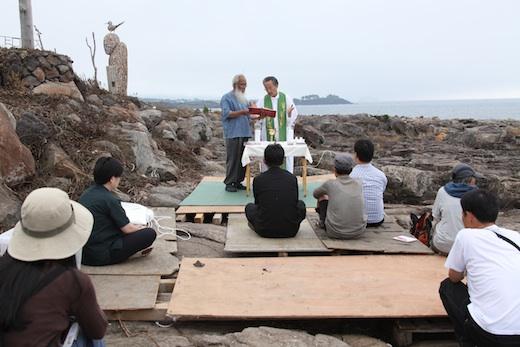
by Jesuit Conference of Asia Pacific
As we look towards Christmas and the hope the birth of Jesus brought us, we remember that in Korea, a Jesuit will be spending his Christmas in prison for standing up for justice.
Korean Jesuit Fr Lee Young-chan and five other peace activists were detained by the police on October 24. He had been protesting the excessive force used by the police in detaining a woman activist, and when the police manhandled him, they claimed his resistance amounted to violence. On Oct 26, the court upheld his arrest and denied him bail. His trial is ongoing.
Fr Lee is the second Jesuit to be imprisoned this year in connection with opposition to the construction of a naval base at Gangjeong Village in Jeju Island. In April, Fr Joseph Kim Chong-uk SJ was imprisoned for opposing and attempting to hinder the construction. Fr Kim has since been released.
The Justice and Peace Commission of the Catholic Bishop’s Conference of Korea and the Korean Province have both issued statements calling for the immediate release of Fr Lee and the other peace activists, and the end of the authorities’ use of violence in Jeju.
The Korean Province also promised continued material and emotional support to the Jesuits engaged in the action in Jeju, saying “With the understanding that this problem is international in scope we will spread awareness of it and join in close solidarity with the Jesuits of North America and also to our own region, the Jesuits of the Asia Pacific.”
In a letter Fr Lee managed to send from prison on November 4, he cites St. Paul saying, “‘For to you has been granted for the sake of Christ, not only to believe in him but also to suffer for him. ‘(Phi1, 27-29) I give thanks that at least in a little way I have been granted the happiness and special favour to directly experience what these words say.”
He further said, “The U.S. and China have been faulting each other while turning N.E. Asia into a powder keg. They are blinded by their hegemony and nationalism and are trying to put each other down. In response, Korea and other nations must join in solidarity, not in inciting war but in ameliorating the situation and in leading toward a reduction in weapons.
“I pray that Jeju may avoid becoming a shrimp caught in a whale fight, but rather prevent the whale fight and become a place brimming with life and peace, an island spreading God’s peace for all peoples to all the world.”
The events in Jeju take place at a critical time for peace in northeast Asia. The ruling party in South Korea has taken a hard line toward North Korea and desires a stronger military to boost national security. The planned naval base on Jeju Island, opening out directly into the East China Sea, will enable increased projection of South Korean naval power. With South Korea’s close alliance with the United States, the naval base could be part of the US’ efforts to encircle China with its military might.
Opposition party lawmakers in South Korea have been critical of the planned naval base and have gained enough agreement for Congress to restrict the budget for this year’s construction. Hopes that the naval base could see a re-examination in 2013 look to be dashed with the ruling party winning the recent presidential election. Construction has been going on 24 hours a day to make up for delays caused by opposition and typhoons. During this time of rapid construction, police presence has been strengthened and their use of violence has increased.
Missioned to the Conference
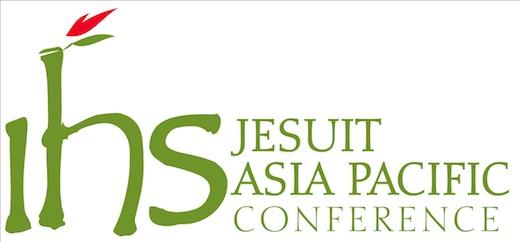
by Jesuit Conference of Asia Pacific
The Conference team is expanding and strengthening. Consultations between the President and Provincials over several months have resulted in the missioning of Jesuits from various Provinces to core positions in the Conference. This generosity of spirit will greatly help the Conference to keep the Society in Asia Pacific oriented towards the service of faith and the promotion of justice.
The appointments announced by Conference President Fr Mark Raper SJ in December are:
Team for the JCAP Tertianship (from August 2013): Fr Priyono Marwan (IDO) and Fr Ramon Bautista (PHI). Fr Roger Champoux (PHI) retires as Tertian Instructor after 14 years in the role.
Socius to the President and JCAP Treasurer (from April 2013): Fr Simon Yi Kuen-sang (KOR-MYN). Fr Simon will also be the Secretary and Development Officer for the Myanmar Mission Fr Benedict Jung will return to Korea after a long absence.
Delegate for Studies (new position, to commence in 2013): Fr Robin Koning (ASL). Fr Robin’s responsibilities will include promotion of the shared responsibility for Jesuit studies across the Conference and implementation of anticipated directives on Jesuit studies from Fr General.
Secretary for Pre-Secondary and Secondary Education (from December 2012): Fr Chris Gleeson (ASL). Fr Chris is appointed for an initial two years in order to re-activate the secondary education secretariat, which is an important network of mutual support and inspiration, especially with new educational projects in planning in many units in the Conference.
Coordinator for the Social Ministries and Coordinator for the Migration Network (from mid-2013): Fr Benny Juliawan (IDO). Fr Benny replaces Denis Kim who has served long in this role, doubling with his academic duties at Sogang University and teaching a course also at Loyola School of Theology. Benny is expected to assume a full time role as Social Ministries Coordinator once he is freed from his duties at Sanata Dharma University. Benny also takes up a new role for coordination of the services offered to people on the move.
JCAP team for planning and office systems (January to mid-2013): Fr Hari Suparwito (IDO). Fr Hari has an interlude between teaching and taking up doctoral studies. In this time he is asked to help streamline and modernize the JCAP information technology systems.
The search for a Formation Delegate to replace the late Fr Matthias Chae continues.
The Conference also continues to make men available to the Curia, and Fr General recently announced the appointment of Philippine Provincial Fr Jose Cecilio Magadia (PHI) as General Counselor for Formation. Fr Magadia will take assume oversight for the formation of Jesuits and vocation promotion in October 2013.
Why Young Adults Need Ignatian Spirituality
by Tim Muldoon
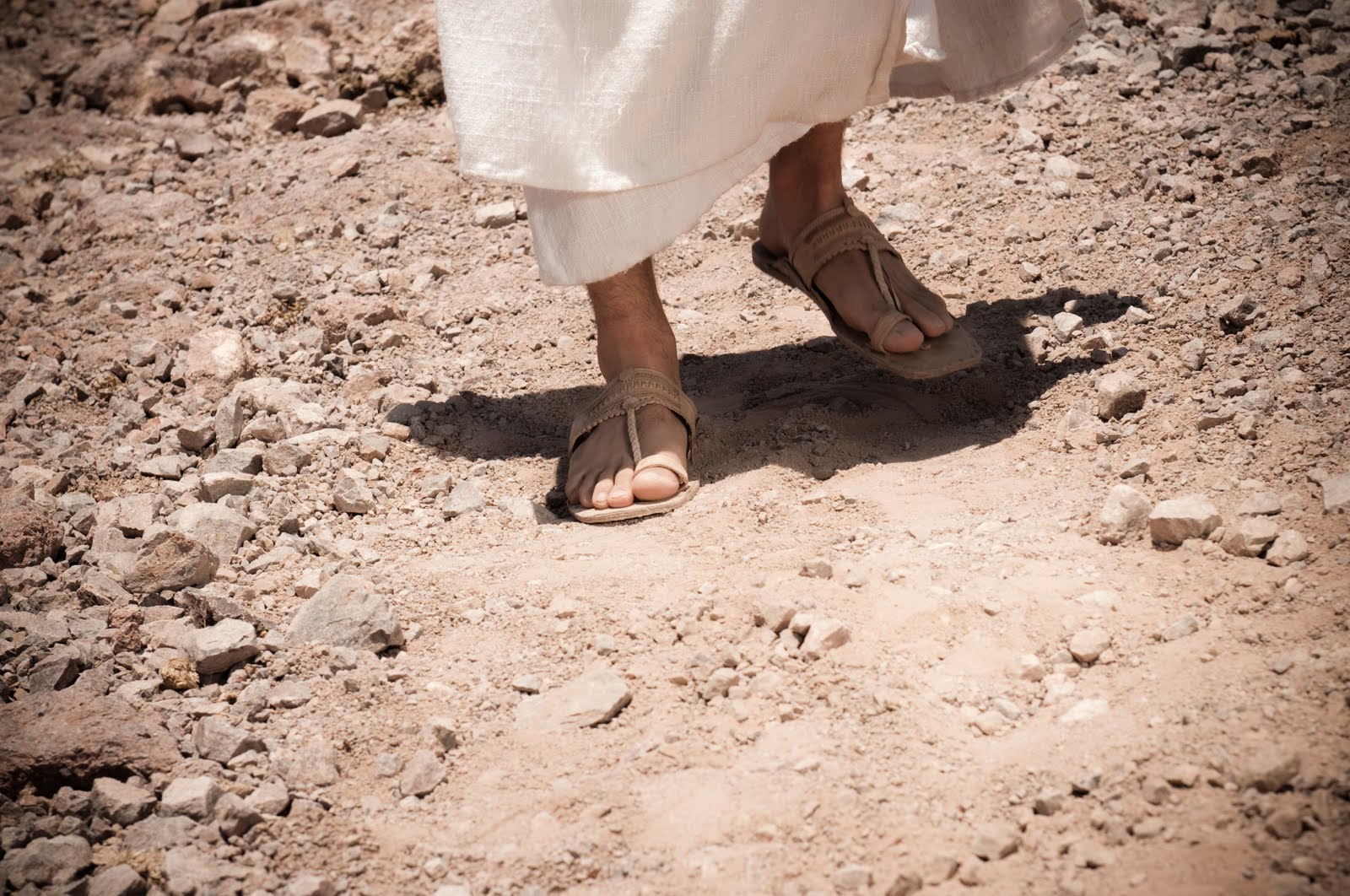
There have been a number of articles and books in recent years that have addressed a basic concern among Church leaders: what will the Church look like in twenty years? Underlying this basic concern is an awareness that the generation of young adults has not (it seems) appropriated Catholic faith according to the models of earlier generations, and thus have not the same commitment to our faith that would seem to be necessary for the future well-being of the Church. Writers such as Tom Beaudoin and Jeremy Langford have contributed articles to America suggesting that there are legitimate faith questions that young people still raise, and that the Church needs to develop a greater understanding of our generation if it is to effectively minister to us. What I offer here is a reflection on how Ignatian spirituality in particular can speak to young people, and help us to develop a vocabulary of faith.
Why Ignatian spirituality? There are two major reasons: the first practical, the second theological. The practical reason is that it is available. There are many Jesuit high schools and colleges in the US, more than any other religious community sponsors, and thus there is a long history of addressing the spiritual and intellectual growth of young people. Ignatian spirituality works because we have learned how to encourage young people to use it. The theological reason emphasises this point even further: Ignatian spirituality emphasises faith as an ongoing dialogue between the person and God, and thus represents the kind of dynamic approach to faith that young people often intuit for ourselves. To see spirituality as that which demands exercise, work, is to see it as more than an either/or proposition – and this latter position is too often presented as the traditional view (‘if you don’t believe in God, you’re going to hell’). Young people live in a world in which we must constantly confront ambiguity and change; Ignatian spirituality recognises this on a very deep level, and invites us to engage in a process of ongoing conversion. This resonates with our experience of confronting the question of God. Many have grown suspicious of facile answers and arrogant claims to authority, and instead need an invitation to consider more clearly the personal question: who is God for me?
There are five elements in Ignatian spirituality which young people today can use to grow in the understanding of their faith:
1. The first principle and foundation
In a postmodern world, the very notion of ‘foundation’ is shaken – can anything be regarded as ‘foundational’ when it seems that everyone believes something different from everyone else? Robert Ludwig has written in his Reconstructing Catholicism (Crossroad, 1995) that younger Catholics have grown up in what he calls a ‘deconstructed’ context and seek a ‘constructive worldview.’ Practically, this means that younger adults have a harder time with anything that can be claimed as incontrovertible truth – even the existence of God – but that we long for clarity. Paradoxically, then, Ignatius’s first principle and foundation can be seen in such a context as remarkably refreshing. It is disarmingly simple: we are created to praise, glorify, and serve God, and by this means to achieve our eternal destiny. Such a suggestion cuts to the heart of our longing for truth, and offers a simple solution: live as though this first principle and foundation were true. Here I am reminded of Ignatius’s own counsel regarding his spiritual exercises: trust God as if everything depended on you, and at the same time work as if everything depended on God.
I recently had an experience which illustrates the attractive power of the first principle and foundation. During an introductory philosophy class, I was addressing how philosophy begins with the sense of wonder at the ‘limit questions’ that confront us as human beings. Among these are questions about death and suffering, love and the meaning of life. Looking out over a room full of only partly interested students, I threw out the offhand comment, ‘You know, the meaning of life is easy: we are created to praise, glorify, and serve God, and by this means to achieve our eternal destiny!’ Immediately, the collective posture of the room changed; everyone sat up straight and began writing, ‘Can you say that again?’ they asked, ensuring that I repeated every word slowly. I had, of course, only lobbed out this comment to catch their attention, but they were fascinated at the idea that one could encapsulate the meaning of life in a handy sentence.
Because we live today in a world where truth claims are constantly weighed and judged against one another, young people have been given very little reason to think that any one way of living is better than any other. Sharing an articulation of Christian faith that is so direct challenges people to consider what sort of truth claim it is, and what kind of life it offers.
2. God in all things
While the notion of ‘God in all things’ is not uniquely Ignatian, it is characteristically so. Among the figures of the last century and a half who have lived this worldview are the poet, Gerard Manley Hopkins, the anthropologist Teilhard de Chardin, and the theologian Karl Rahner. All of these figures had a strong sense of what Hopkins called ‘the dearest freshness, deep down things’ – that sense that God’s grace animates the whole of the created order to the extent that one cannot but encounter it if one is attuned to it. The celebration of God’s grandeur appeals to the young mind, which sees a panorama of people, traditions, beliefs, and styles among people, and can draw meaning from places very different from the traditional sources of Catholic worship. In short, young people today draw their spirituality from many non-traditional places, especially those in pop culture, as Tom Beaudoin has written in his Virtual Faith (Jossey Bass, 1997).
To speak about God in all things is to admit that no doctrine, no tradition, no scripture alone can exhaust the mystery that is God. It is to remember that our theology, our prayer, our teaching is limited in its ability to convey this myst ery, and that as a result we must ultimat ely stand in awe before God. We who have grown up in a pluralistic world have seen good things in people of varied backgrounds; we know that any talk of ultimate truth must be humble before the vastness of human experience and of creation. On the flip side, to speak of God in all things is to remind us that ours is a sacramental understanding of God – God among us in the face, the word, the gesture that makes present the reality of grace. It is to emphasise that God is not distant and ‘other’, but present and intimate with us. It is to underscore a belief that our lives are not beyond the scope of God’s love, but rather they are already the objects of God’s care.
3. Walking with Christ
Ignatius’s Spiritual Exercises asks the retreatant to enter deeply into the stories of Jesus’s life, to use the imagination to place oneself into the Gospel stories. This spirituality is about sharing in the story, not only by remembering it but also by taking part in it, in order that one might more fully come to know Jesus. Today, this counsel is still valuable to young people, many of whom know the gospel only second-hand. I have had many experiences in which people have commented on how surprised they were by the Jesus of the Gospels, because they had never had the chance to meet him directly. Too often young people rely on the faith of parents, and so never are given the opportunity to really confront for themselves this attractive figure (‘Who do you say that I am?’), and to answer the fundamental call: ‘Come, follow me.’ Young adults undergo a period of distancing themselves from their parents, and part of this distancing involves religion. They need the chance to appropriate their own mature faith, and asking them to consider the real Jesus can be an important step.
4. Consolation and Desolation
Perhaps the most important part of the spiritual journey that young people need to understand is that it is not a straight, easy path towards enlightenment, but rather a struggle that involves highs and lows. Ignatius’s writing on the discernment of spirits is helpful, because it gives us an understanding of how both consolation and desolation are part of the life of faith. Ignatius shows God as one who loves us deeply, but who moves us toward growth even in the periods when God is distant. In short, Ignatius shows us that spiritual suffering is part of the life of faith, and that it forces us to confront the false images of God that prevent us from growing as human beings. For young people, this is a hard message, but so necessary in a culture that says, avoid all suffering. My generation has grown up in a sound-byte, throw-away culture, and we have learned that it is possible to insulate ourselves from reality by turning our short attention spans to the next interesting thing. We need a spirituality that emphasises that faith is sometimes about choosing to confront reality, to trust God even when God is hard to understand – for example, in the face of such mysteries as the death of a loved one or experiences of failure and loss.
5. Social Justice
An important final element in Ignatian spirituality that distinguishes it from so many ‘self-help’ spiritualities in the marketplace is that of social justice. Jesuit education has stressed that Christian faith reaches out to others, and does not rest content with a doctrine of personal fulfilment. As much as young people today are criticised for our self-centeredness, many of us long for the sense that we can make a difference in the world. Having inherited an individualistic worldview, we find that it can be difficult but rewarding to show concern for others. One benefit of living in a pluralistic world is that we have come to appreciate the legitimate differences among people, and so we have a sense that all people share a basic moral equality. We must be reminded, though, that in spite of our culture’s tendencies to exalt the individual, we are called to reach out to people who are left out.
Jesuit institutions have led the way in making the spiritual teachings of St Ignatius available to all people. In my own experience, the so-called ‘19th annotation retreat’ described in the Spiritual Exercises is a great way to offer students the opportunity to learn about and practise this spirituality. I have made the retreat at two different Jesuit institutions, and have helped run it in a university Newman centre, and so I know that it can attract people from different walks of life and help them to grow in their faith lives. Perhaps more than anything else, the invitation to try authentic Christian spirituality is vital if we want to encourage the faith of young people. Ignatian spirituality is good because it offers such an invitation – that people might come to know for themselves what it means to follow Christ.
Tim Muldoon is a Catholic theologian and author of several books, including The Ignatian Workout, an adaptation of Saint Ignatius Loyola’s Spiritual Exercises. He is married with three children, and teaches at Boston College, where he also serves in the Division of University Mission and Ministry.
This is an amended version of an article published originally by America in February 2001. Reprinted with permission.
Wisdom Story 49
by Rev Dr Richard Leonard SJ

It is said that after the Buddha experienced enlightenment, he passed a man on the road who was immediately struck by the Buddha’s appearance. The Buddha had an extraordinary radiance and peacefulness about him. The man knew he was in the company of an unusual person and he wanted to know more about him. Thus, he stopped and asked the Buddha.
“My friend, what are you. Are you a celestial being, or perhaps a god?” “No,” said Buddha
“Well then, are you some kind of magician or wizard?” “No,” said Buddha again.
“Are you a man?” “No.”
“Well, my friend, what then are you? This time the Buddha replied, “I am awake.”
European Martyrs of the Society of Jesus (memorial)

Fr Jacques (James) Sales and Brother Guillaume (William) Saultemouche, both French, died in Aubenas, France, in February 1593 during France’s War of Religion.
Jacques Sales wanted to be a missionary and wrote Father General Claudio Acquaviva to be accepted anywhere – America, China or Japan. The response was negative; Father General reminded him that France itself was a mission territory, given the conflict between Catholics and Huguenots (French Calvinists).
Brother William Saultemouche (1557-1593) served as porter at Pont-à-Mousson and was known for his simplicity and gentle character. He was chosen to accompany Fr Jacques Salés on a mission to give sermons in Aubenas, a town that the Catholics had regained control of from the Huguenots. The baron of Montréal wanted someone who could refute the Calvinist ministers. Salés began preaching in Aubenas and other places on 29 November 1592 explaining Catholic belief in an ecumenical way. He returned with Saultemouche on 5 February 1593 because tension between Catholics and Huguenots was increasing. On the same day they were grilled by Huguenots to deny their faith but refused. They were shot and stabbed and their bodies dragged through Aubenas and then dumped. Catholics retrieved the bodies and buried them.
Fr Joseph Imbert and Fr John-Nicholas Cordier, also French, died on prison ships in Rochefort in 1794 during the French Revolution.
Joseph Imbert was born about 1720 in Marseilles, France, and joined the Jesuits in Avignon. He was in Grenoble when the Jesuits were suppressed in 1762. He became a diocesan priest but had to step down when he refused to accept the 1790 Civil Constitution on the Clergy and then worked underground. As vicar apostolic he was arrested in 1793 during the Reign of Terror. He was condemned to be deported on a former slave ship to Africa. On 13 April he was put on a prison ship anchored near the Charante River. Four hundred priests were crammed below decks in appalling conditions. After two months Joseph died of typhoid. He was buried on a nearby island with 226 other priest-victims.
John Nicholas Cordier was born in 1710 in Souilly, in the Duchy of Lorraine, and joined the Jesuits in 1728. He taught philosophy at Strasbourg and then theology at Pont-à-Mousson. He later was prefect of studies and superior of the Jesuit residence in Saint-Mihiel. After the Jesuits were suppressed, he became chaplain to a convent of nuns.
In 1790 the government suppressed all religious orders in France, and Cordier was taken in by and accepted shelter from a priest in Verdun. On 28 October 1793 he was arrested and ordered to be deported. He waited for six months to be sent to Africa and, on 19 June 1794, was put on a slave ship which could not leave because of an English blockade. The living conditions were beyond endurance. When Cordier became ill, he was moved to a temporary hospital, which was better than the ship but he died there and was buried with 254 other victims.
Fr Ignatius de Azevedo, born in Portugal, and 39 Jesuit companions were martyred off the Canary Islands in July 1570, while sailing for the Brazil mission.
Ignatius de Azevedo had been an educationalist in Portugal when Fr General Francis Borgia made him Visitor to Brazil where he arrived in 1566. He was then made Provincial of Brazil and told to recruit more missionaries from Portugal and Spain. He gathered 70 volunteers – priests, scholastics and even novices. On 5 June 1570 they left in eight ships passing by the Canary Islands. Fr Azevedo was on a ship with 43 companions. Approaching Sta Cruz de La Palma, they were intercepted by French Huguenot pirates. The pirates boarded the missionaries’ ship and set about killing all in cassocks, beginning with Ignatius. Only one Jesuit survived because he could cook. When the ship reached La Rochelle in France, he escaped and brought the news to Portugal.
James Julius Bonnaud, born in 1740, was a native of Haiti who joined the Jesuits in France in 1758. After his theology studies and ordination in Flanders, he returned to Paris to work in the diocese. He wrote against the revolutionaries and their anti-papal Civil Constitutions, making himself a target for the revolutionaries.
As it progressed the French Revolution became rabidly anti-Catholic. Property was seized, religious orders suppressed. Priests were then required to sign an oath for a national church independent of Rome, with severe penalties for those who refused. Then on 2 September 1792, with invading Prussians and Austrians near the gates of the city, the Paris Commissar decided to kill all priests. Among those martyred were James Bonnaud and 13 other Jesuits among 95 priests at a Carmelite friary. They were locked into a chapel and, those who refused to sign the oath, were thrown down a flight of stairs to a mob who attacked them with all kinds of weapons. Altogether14 Jesuits were martyred. With James Bonnaud were: William Anthony Delfaud, Francis Balmain, Charles Berauld du Perou, Claude Cayx-Dumas, John Charton de Millou, James Friteyre-Durve, Claude Laporte, Mathurin Le Bous de Villeneuve, Claude Le Gue, Vincent Le Rousseau de Rosancoat, Loup Thomas-Bonnotte and Francis Vareilhe-Duteil.
These fourteen Jesuits, with nine others, were beatified by Pope Pius XI on 17 October 1926 together with 168 other French priests.
These martyrs are remembered for their fidelity to Christ, their allegiance to the Catholic Church, and their sufferings at the hands of fellow Christians and fellow citizens.
Film Reviews : Parental Guidance
by Rev Dr Richard Leonard SJ

PARENTAL GUIDANCE. Starring: Billy Crystal, Bette Midler, Marisa Tomei, Tom Everett Scott, Joshua Rush, Bailee Madison, and Kyle Harrison Breitkopf. Directed by Andy Fickman. Rated PG (Mild themes). 105 min.
This American family comedy has been produced for holiday-time enjoyment. When their busy daughter, Alice Simmons (Marisa Tomei) takes time off to be with her working husband, Phil (Tom Everett Scott), Artie Decker (Billy Crystal) and his wife, Diane (Bette Midler), fly in on request to babysit their three children, Harper (Bailee Madison), Turner (Joshua Rush) and Barker (Kyle Harrison Breitkopf). Recovering from just losing his job, Artie is reluctant, but Diane is willing to help.
The Simmons family live in a house with a centrally operated, automatic computer system, which manages everyone inside it, and before long, things go inevitably wrong. Artie and Diane try modern-day methods to control their grandchildren, and eventually succumb to applying the methods their own parents employed to keep them in check when they were children.
Artie is an old-style parent, and Diane desperately likes to please anyone who asks something of her. They quickly discover their own inadequacies as parents, but not before the grandchildren put them through some exasperating paces. At the end of it all, one knows that love and understanding will shine through, and they do, and there is never any risk to family-values eventually winning the day. Messages abound about believing in yourself, the significance of closeness and empathy, and the importance of being loved.
This is a generation comedy that pits parents and grandparents against modern-day grandchildren. Not surprisingly, the grandchildren are computer-savvy and use their expertise to confuse and befuddle, and they are particularly adept at making sure their manipulative strategies succeed. After enduring embarrassment on several fronts, Artie finds himself battling modern day technology to beat his grandchildren at their game by applying old-fashioned methods based on warmth and affection.
Both Billy Crystal and Bette Milder are very good comic talents, and they give everything they have to a comedy that relies heavily on situational farce. Their acting style is well suited to finding comedy in ridiculously difficult situations, and they rise to the challenge. Facial shock, confusion, mock horror, and surprise are their forte, and they engage in frequent one-liners that communicate their frustrations wittily, while also extracting our sympathy.
Comedies that depend on farce for their impact always work better in some situations than in others, and this film is no exception to that rule. When smiles and laughter come in this movie, Crystal and Midler are nearly always there in the centre of them. Consistent with the film’s classification, some of the language is coarse, but for the most part, crudity is kept well in check and the film is reasonably child-friendly.
The film is laughter-producing, reliable fare for the holiday season, and shows two highly seasoned comedians at work, having a good time. There are no stabbings, horror scenarios, or gut-wrenching scenes, only grand-parents and their charges trying to cope with each other in fairly predictable ways, and with a heavy dose of sentimentality thrown in at the finish for good measure.
This movie is a relatively slight one, and no where near the quality of “Parenthood” (1989), but it is a movie that clearly entertains. One does not go to this film to learn how parents or their children should behave intelligently. Rather, one goes to smile and understand, and to know that it will all turn out well in the end.
Rev Dr Richard Leonard SJ is the Director of the Australian Catholic Office for Film and Broadcasting (ACOFB).Peter W. Sheehan is associate of the Australian Catholic Office of Film and Broadcasting.





